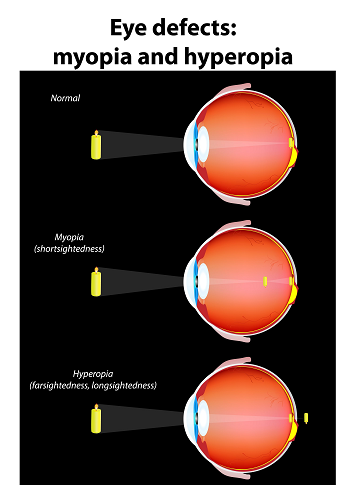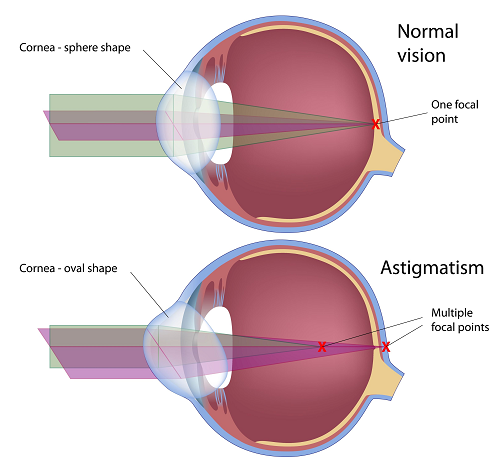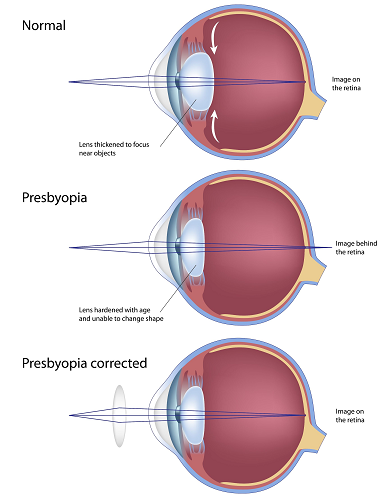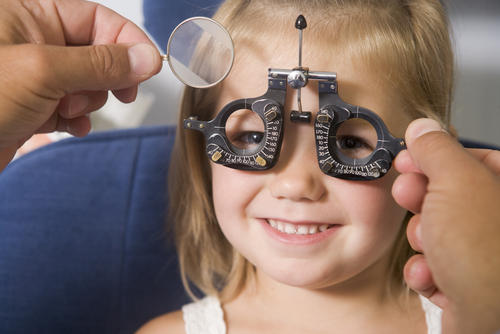Myopia (Nearsighted)
Myopia is the medical term for what most people call nearsightedness. Myopia is typically the result of the eye being too long or the curvature of the cornea being too steep. It is a condition where distant object are more blurry and you can see objects clearly only when they are closer. Myopia usually develops in early childhood, though it sometimes develops in early adulthood. In rare cases, myopia can lead to more serious conditions such as a retinal detachment.
Myopia is considered to be a genetic disorder. If your parents are nearsighted, you are at greater risk of also being nearsighted. Another risk factor is “near work” – work involving fine detail or focusing on close objects; the more near work you perform, the more likely you are to be nearsighted. People with uncorrected myopia often experience difficulty focusing far away They commonly are found squinting and experience differing levels of eyestrain.
Myopia is typically corrected with eyeglasses or contact lenses. Sometimes myopia continues to gradually worsen throughout life. Myopia can also be corrected by LASIK surgery and other refractive surgical procedures.

Hyperopia
Hyperopia is more commonly known as farsightedness. Hyperopia is typically the result of the eyeball being too short or the curvature of the cornea being too flat. As the name suggests, people with farsightedness are able to focus on objects that are further away, but have difficulty focusing on objects which are very close. About a quarter of the population are afflicted with hyperopia. Hyperopia can lead to chronic glaucoma, a more serious condition, later in life.
A family history of hyperopia is a risk factor for developing hyperopia. If your parents are farsighted, you are at a greater risk of also being farsighted. Often babies are born with hyperopia, but they usually outgrow the condition as the eye develops.
People with uncorrected hyperopia often experience difficulty focusing up close, headaches, eyestrain and fatigue. Many eye screenings are ineffective in diagnosing hyperopia.
Hyperopia is typically corrected with eyeglasses or contact lenses. There are also refractive surgical procedures that can correct hyperopia.
Emmetropia
When an eye’s optical power is perfectly matched to its length, the eye is said to be emmetropic. Emmetropia is the medical term for 20/20 vision needing no corrective lenses, contact lenses, or reading glasses. It occurs because the optical power of the eye can perfectly focus an image to the retina, giving them “perfect” vision.

Astigmatism
Astigmatism is typically the result of an irregular shape of the cornea or the lens-this causes the eye to focus an object on two different areas of the retina at the same time. For the cornea to bend light correctly, it should be dome-shaped, like a basketball. Astigmatic corneas are shaped more like a football. This causes a distorted view when looking at objects which are close-up and far away.
The cause of astigmatism is unknown. Astigmatism is often associated with myopia or hyperopia, and usually occurs from birth. In some cases astigmatism is caused as the result of an injury to the eye.
People with astigmatism often experience blurred vision, headaches and eyestrain. Most people have a mild amount of astigmatism and it usually doesn’t need to be corrected. Higher amounts of astigmatism can be corrected with eyeglasses, contact lenses, or refractive surgical procedures.

Presbyopia
Presbyopia is a condition where the lens of the eye gradually looses it ability to flex and focus up close. It typically begins earlier, but is first noticed by patients as the approach their early to mid 40’s.
Presbyopia is a natural part of the aging process. There is no cure, though researchers are constantly looking for one. Even if a someone has never had vision problems before, they can still develop presbyopia. It may seem to occur suddenly, but actually occurs over a long period of time.
People with presbyopia often experience blurred vision up close. They often have to hold objects further away to bring them into focus. Often they will say “my eyes are fine, but my arms aren’t long enough”. Other symptoms include eye strain, fatigue, and headaches from near work.
Many options are available to treat presbyopia including reading glasses, bifocals, trifocals, progressive lenses, contact lenses, monovision and more.

Amblyopia (Lazy Eye)
Amblyopia, commonly called lazy eye, occurs when one eye does not see as well as the other because the eye and the brain are not working well together. The eye looks normal, but it is not functioning properly because the brain favors the other eye.
People with amblyopia are difficult to diagnose as they can often use the other eye to compensate. Sometimes you may notice them favoring one eye or bumping into objects on one side. Amblyopia typically develops before the age of 6. The best way to tell if your child has lazy eye is through a complete exam around six months and three years. Early diagnosis can prevent amblyopia from leading to more serious problems such as loss of the ability to see three dimensions or functional blindness in the amblyopic eye. Early diagnosis is the key with this condition.
Amblyopia is not correctable with eyeglasses or contact lenses alone. Often prism and eye patching are necessary. Typically some level of visual therapy is necessary to teach the eyes to work together. Treatment is not always effective. Early diagnosis and treatment will give the best chance to a full recovery.

Strabismus (Crossed Eyes)
Strabismus, commonly called crossed eyes, is a condition where the muscles of the eye do not allow the eye to align properly and one or both eyes turn. The eye(s) may turn in, out, up, down, or a combination of these. This condition is more noticeable when the person is tired. Crossed eyes are often easier to see in photographs.
Patients with strabismus may experience blurred vision or double vision. There are times when the brain will “shut off” one eye to prevent double vision. This may cause the eye not to develop properly. Early diagnosis and treatment are necessary in these cases as they can prevent permanent decreases in vision.
Treatment for patients with strabismus may include glasses, prism, visual therapy and in some cases, surgery. This condition will not get better on its own, though it may get worse. Treatment for strabismus is not always fully effective. Early intervention gives the best the chance for a complete recovery.

Computer Vision Syndrome
Computer vision syndrome (CVS) affects three out of four computer users. It is a series of symptoms related to extended periods of computer usage.
Your vision, your computer, and the environment where you use your computer are all factors which can lead to CVS. Though it is no cause for panic, measures can be taken to relieve symptoms of CVS.
People with Computer Vision Syndrome may experience a variety of symptoms. Headaches, eye strain, neck and back aches, sensitivity to light, blurred vision, double vision, dry or irritated eyes, and color distortion are all possible problems related to CVS. A person with CVS may experience any combination of these symptoms.
There are many options for treatment of CVS, depending on the symptoms each person is experiencing. Often times having glasses specifically made for the computer can help relieve many symptoms. Dry eye treatment is often necessary-when on a computer, we blink our eye approximately 1/3 as often as we should. Many other options are available to assist in relieving symptoms, such as changes being made in the workstation, changing settings on the computer and more. A thorough evaluation and discussion is needed with your optometrist to determine what the best options are for you.
